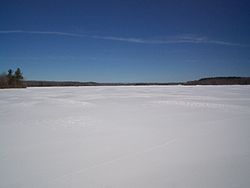Stillwater Lake (Pennsylvania)
| Stillwater Lake | |
|---|---|

Stillwater Lake in the winter
|
|
| Location | Coolbaugh Township / Tobyhanna Township, Monroe County, Pennsylvania, US |
| Coordinates | 41°07′19″N 75°25′26″W / 41.1219°N 75.4239°WCoordinates: 41°07′19″N 75°25′26″W / 41.1219°N 75.4239°W |
| Type | artificial lake |
| Primary inflows | Dotter's Run Stream Hawkeye RunStream Pocono Summit Creek |
| Primary outflows | Tunkhannock Creek |
| Basin countries | United States |
| Max. length | 0.87 mi (1.4 km) |
| Max. width | 1.24 mi (2.0 km) |
| Surface area | 315 acres (127 ha) |
| Average depth | 4.7 ft (1.4 m) |
| Max. depth | 8 ft (2.4 m) |
| Water volume | 1,480 acre·ft (1,830,000 m3) |
| Surface elevation | 1,811 ft (552 m) |
| Islands | 6 |
Stillwater Lake is a reservoir that covers approximately 315 acres (1.27 km2). The lake is located in Pocono Summit, Pennsylvania at an elevation of 1,811 feet (552 m). Fed by Dotter's Run, Hawkeye Run, Pocono Summit Creek, and several underground springs, the lake flows out to Lake Naomi via Tunkhannock Creek. There are several Tunkhannock Creeks in the Poconos. This one merges with the Tobyhanna at Pocono Lake. The Tobyhanna flows into the Lehigh, and ultimately into Delaware Bay.
The lake is currently home to Stillwater Estates, and to Camp Minsi, a facility owned by the Boy Scouts of America's Minsi Trails Council.
The area where the lake is located was once a swamp. The Native Americans of the area called it "Klampeechen Chuppecat" which, in Lenape, translates to deep, dark swamp.
In the 1870s, like most of the land in the Pocono Plateau, the land was clear-cut and harvested for lumber. The swamp was destroyed and cut away to make room for a man-made lake designed to transport the cut timber downstream to sawmills. A dam was built to control the water flow and the level of the lake, while three very small streams and underground springs fed the newly made lake, which was originally called Tunhannock Lake. Tunkhannock Creek was the major outlet for the lake and logs were sent down Tunkhannock Creek to Lake Naomi and then onto a sawmill on Lake Pocono.
With the dwindling forests and growing markets, the businesses who had harvested all of the lumber began looking for new avenues of revenue—they turned to the ice industry. From the late 1880s until the 1930s, the ice industry of the Poconos was king. Numerous ice companies sprung up in the area as ice was harvested from the shallow freshwater lakes. Soon, the Pocono Mountain Ice Company, run by Samuel Rubel, became the leading ice company in the area, buying up many of the smaller ice companies. Large ice houses were built around Lake Stillwater to store the large blocks of ice. Remnants of some of those facilities can still be seen on the south and eastern side of the lake today.
...
Wikipedia
